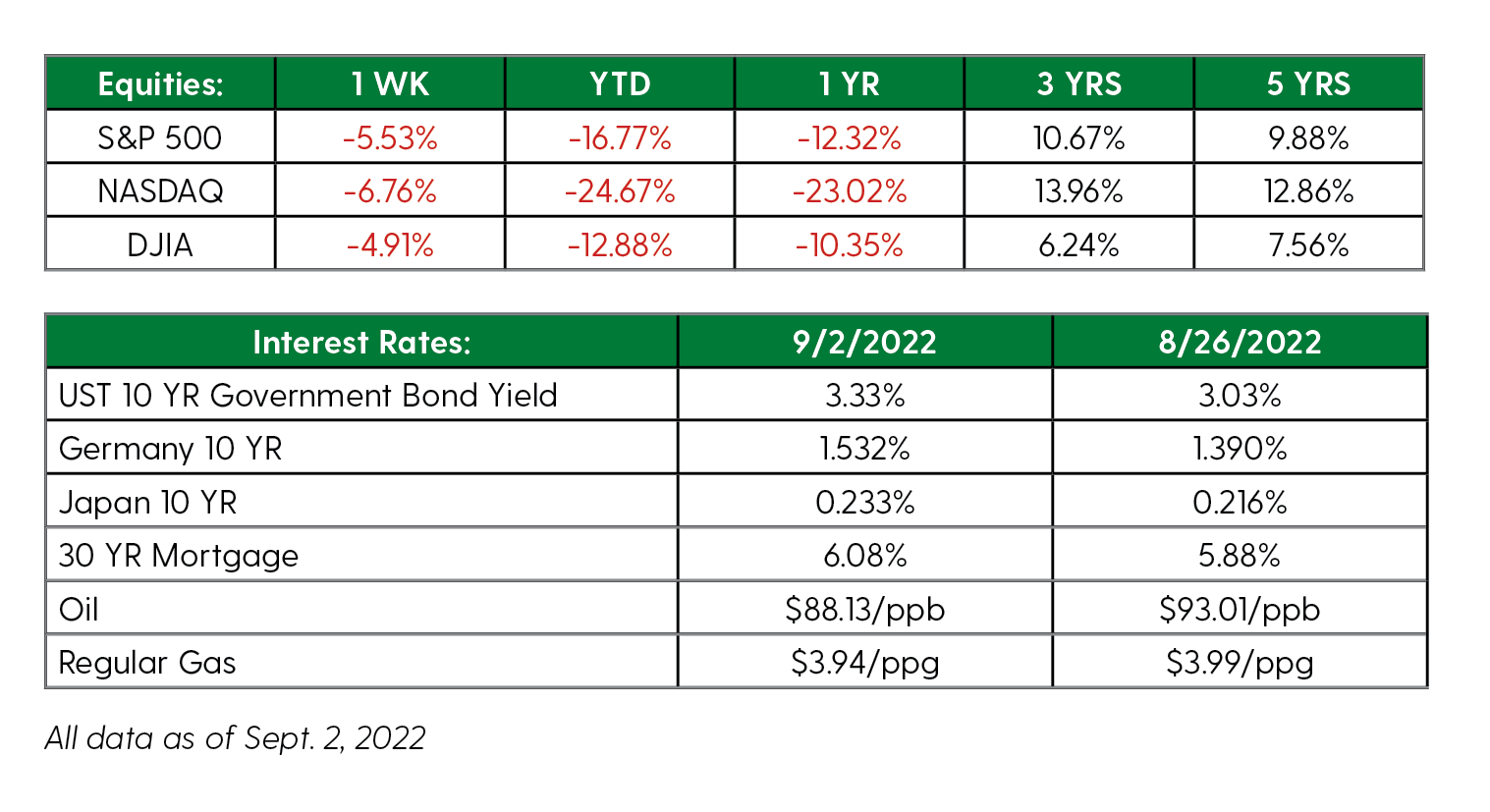AE Wealth Management: Weekly Market Insights 8/28/22 – 9/3/22

Weekly Market Commentary
THE WEEK IN REVIEW: Aug. 28 – Sept. 3
Markets continue downward slide
Jobs reports reinforce Fed’s interest rate stance
After Federal Reserve Chairman Jerome Powell’s speech at Jackson Hole on Aug. 26 sent markets sharply lower, the selling continued last week with the S&P 500 dropping below 4,000. The recent rally appears to have ended and looks increasingly like a classic bear market rally.
The Job Openings and Labor Turnover Survey (JOLTS) number didn’t offer any comfort to the market that job growth might be slowing, which may lead to slower wage inflation and convince the Fed to become less aggressive. Job openings increased more than expected, at 11.24 million vs. the expected 10.3 million. This number beats the previous high of 11.04 million openings in June and comes in at about two openings for every unemployed person.
In the good news is bad category, consumer sentiment rose for the first time in three months. The bulk of that confidence was likely brought on by the drop in gas prices the past month. Both the job openings report and the improvement in consumer sentiment did little to relieve markets’ anxiety that the Fed might blink in the face of weaker data. Instead, the data was stronger, which only cements the Fed’s stance.
Other jobs news was mixed. The ADP corporate payroll number was weaker than expected, coming in at +132,000 vs. expectations of 288,000. (A note: ADP took its index offline the past two months to make changes that would make the ADP reading an independent indicator of labor market conditions instead of trying to forecast the Bureau of Labor Statistics’ payroll number, time and conditions. It remains to be seen if they’re on the right track.)
Finally, on Friday the August non-farm payrolls report showed we added 315,000 jobs last month, over the expected 300,000. At first, the markets rallied because the actual jobs number did not come in way over consensus and seemed to be a “goldilocks” number — neither too hot nor too cold. However, traders realized that in order for unemployment to remain steady or even rise, job creation needs to be about +100,000 per month. At +300,000, we’re still in a hot jobs market.
The hope that the lower jobs number might cause the Fed to blink was short-lived as markets sold off on Friday. The pre-holiday, thinly traded markets only accelerated the selling.
Student loan forgiveness and its economic impact
Last week we discussed the decision by President Joe Biden to institute a plan to forgive up to $10,000 in student loans and up to $20,000 in Pell grants per borrower. The projected cost of the program has ballooned from $300 billion to (by some estimates) up to $1 trillion. Some will argue the program is unconstitutional and not within the president’s power to enact since Congress would need to pass a law for a new entitlement program, an argument that will be settled in court.
The administration and some outside of it have stated the proposed program will not add to the national debt or fuel inflation. But we have recent experience with rent moratoriums, direct government payments and student loan deferrals during the pandemic as examples of transfer payments that have led to increased inflation. This massive program will create more inflationary pressure when we least need it. We have yet to see any details about how the program will be paid for, other than the $300 billion deficit reduction over the next 10 years as outlined in the Inflation Reduction Act (IRA).
From an economic standpoint, reducing (or even eliminating) student loans allows consumers to spend their dollars elsewhere. However, the current forgiveness plan doesn’t seem to account for the potential impact on already high inflation rates. It also seems to be merely a bandage and doesn’t address the root issues, namely the ballooning cost of an education and predatory interest rates on student loans. Unless we figure out a solution for those problems, we’re likely to repeat this cycle and rehash the same conversations.
Coming this week
- With summer vacations over and kids back in school, Wall Street’s first stringers will return to their trading desks to assess the current situation. Given all that has happened over the past few weeks, it’s difficult to imagine a positive view emerging.
- Data will be scant this week. The Beige Book will be published by the Federal Reserve on Wednesday. This document is published eight times each year and includes anecdotal information on current economics in each Federal Reserve Bank district. The data is collected through reports from bank and Fed branch directors, as well as interviews with key business contacts, economists, market experts and other sources.
- Unemployment claims and consumer credit numbers will be released Thursday.
- It will be interesting to see this week whether traders decide the recent rally is over. Are we in for a challenging month given the Fed’s September rate pause is no longer in play? Or will we continue to move forward? We’re curious to see what the catalyst to move upward looks like because it’s not obvious at this point.

AE Wealth Management, LLC (“AEWM”) is an SEC Registered Investment Adviser (RIA) located in Topeka, Kansas. Registration does not denote any level of skill or qualification. The advisory firm providing you this report is an independent financial services firm and is not an affiliate company of AE Wealth Management, LLC. AEWM works with a variety of independent advisors. Some of the advisors are Investment Adviser Representatives (IAR), who provide investment advisory services through AEWM. Some of the advisors are Registered Investment Advisers providing investment advisory services that incorporate some of the products available through AEWM.
Information regarding the RIA offering the investment advisory services can be found on https://brokercheck.finra.org/.
Investing involves risk, including the potential loss of principal. No investment strategy can guarantee a profit or protect against loss in periods of declining values.
The information and opinions contained herein, provided by third parties, have been obtained from sources believed to be reliable, but accuracy and completeness cannot be guaranteed by AE Wealth Management.
This information is not intended to be used as the sole basis for financial decisions, nor should it be construed as advice designed to meet the particular needs of an individual’s situation. None of the information contained herein shall constitute an offer to sell or solicit any offer to buy a security or insurance product.
9/22-2410942-1
